Introduction
On June 3rd, Tesla “rooftop rights” owners voiced their complaints again. In May, Tesla’s sales in China dropped by nearly half, coupled with other negative news, Tesla’s market value evaporated by nearly 200 billion yuan ($31 billion) in one day; More recently, Tesla has frequently been in the news as the police have been involved in incidents across the country. On May 19th, in Zhejiang province, a Tesla collided with two traffic police officers who were handling an accident, and one of the officers died unfortunately.
However, finally there is good news coming from the United States, also related to the police: Tesla police cars saved a huge amount of money for Westport, Connecticut. Let’s take a look at what happened.
Return of the Police Station
In 2019, the Westport Police Department in Connecticut added a new Tesla Model 3 patrol car to its fleet. Critics were somewhat uneasy about this car, which cost $52,000, compared to a typical Ford Explorer police car, which costs only $37,000. The latest financial data shows that choosing the Tesla Model 3 as a police car has paid off, and compared to that, the city has saved tens of thousands of dollars. The Connecticut EV Club analyzed this data.
In short, the Tesla Model 3 police car brought huge cost savings. In fact, the premium paid for the purchase was recovered in just one year. Barry Kresche of the EV club shared a four-year cost forecast report, which showed that the money saved was enough to let the police department “free of charge” buy another Tesla.
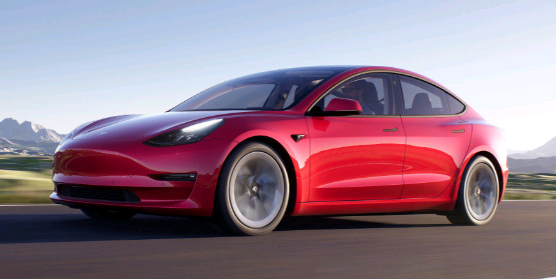
It is worth noting that when purchasing trial-use Tesla patrol cars, the city received a discount for trial-use vehicles, so no extra money was spent on additional cameras, lights, sirens, and weapon racks. These discounts were only a little over $14,000. However, even without the $14,000 discount, the economic savings would be enormous. Barry also found that an electric police car can save the city 23.5 tons of carbon dioxide emissions per year.
Barry pointed out that his analysis of all data related to procurement, customization, and operating costs came from the police in Westport, who verified the accuracy of the data at his request.
This analysis is a sharp response to those critics who mocked the purchase of the Model 3 (such as “52,000 dollars is a joke”). This shows that although Tesla is a high-end car, its cost is affordable. The city has made an investment, and in the first year, this investment has paid off. By the fourth year, using only the money saved from not buying Ford Explorer patrol cars, the city should be able to buy another new Tesla police car.The data analyzed by Barry and the data confirmed by the city include three vehicles – trial Model 3, the next Tesla, and the typical Ford Explorer police car used in many cities across America.
The next Tesla is assumed to be the second vehicle without a one-time discount, which makes the comparison quite fair.
The chart below includes trial Tesla Model 3, the next Tesla Model 3, and the traditional Ford Explorer.
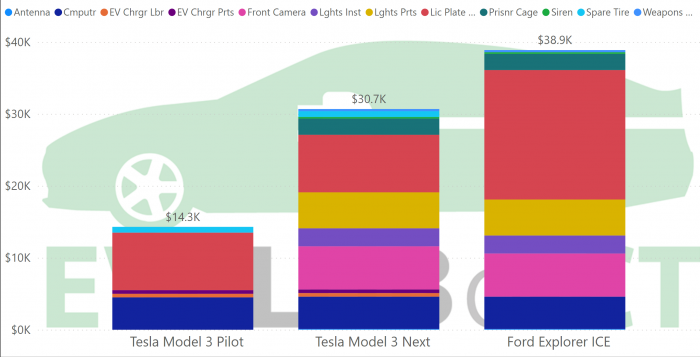
Cost comparison
The largest single item in the Tesla patrol car customization is the license plate reader. Since Tesla has its own technology in this area, which is a strength, $10,000 was saved here. The cost of the Ford Explorer license plate reader is $18,000. It should be noted that the Model 3 is not equipped with a prisoner transport cage/partition because the car’s mission does not require it. However, Barry included its cost in the next Tesla’s cost for comparison.
There are two items that apply only to Model 3, one is an $800 spare tire and the other is a charging station with hardware and installation costs of $1,000. The Ford Explorer has a spare tire.
Model 3’s customization cost decreased by $24,600, especially due to the trial vehicle discount. The pricing of the next Model 3 has no discount, but due to the savings on the license plate reader, its customization cost is still $8,200 lower than the Ford Explorer.
Ongoing Cost and Lifespan
These costs are calculated based on driving 23,060 miles (37,000 kilometers) a year, not only including fuel. Although the fuel is given, Barry’s data also includes other regular maintenance items. For both vehicles, they include brakes and tires. Ford’s brake frequency is four times that of Tesla’s. For tires, Ford’s replacement frequency is twice that of Tesla’s. Both cars use the same type of tires, but the police noticed that the tires on the Tesla are somewhat different – they perform better on the Tesla. The police attributed this to the Tesla’s advanced suspension.
As a gasoline car, the Ford has much higher maintenance costs than Tesla, including oil and filter changes, transmission repairs, catalytic converters, water pumps, spark plugs, and alternators. The data also shows that the cost of electricity used by Tesla is 60% lower than that of the 2020 Ford that uses gas. In addition, the Model 3 has not added the air conditioning heat pump praised by Musk, which is said to reduce energy consumption and increase range in cold weather.
As for the lifespan, it is recorded that the Ford Explorer, as a police car, has a lifespan of four years.
Total CostBarry pointed out that, according to the police, they believe that Tesla will have a lifespan of 6 years. Therefore, the cost should be calculated based on cash and depreciation.
In the chart, the total cost of each car – purchased Tesla, next Tesla, Ford Explorer – is shown for three categories over four years. The categories include purchase, customization, and ongoing projects.
The graph displays cost accounting based on the “realization of revenue and payment” principle. The two blue blocks represent fixed purchasing and customization costs that do not change over the four-year period. The orange block represents ongoing costs that increase each year only with more fuel usage and additional maintenance projects. Therefore, over a period of time, using a Ford Explorer costs more than using a Tesla, even the next Tesla.
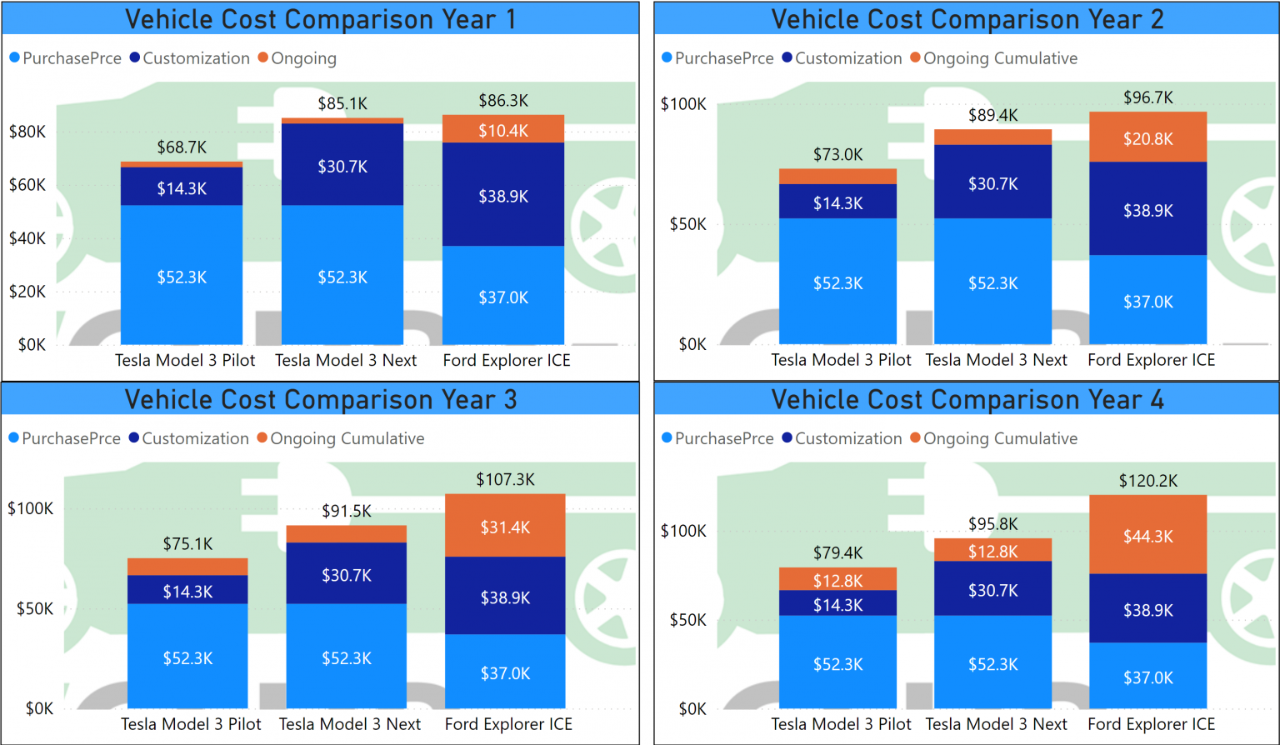
The following chart summarizes the four-year cost trend of each car, still based on the realization of revenue and payment principle, and is associated with the total number in the classification table.
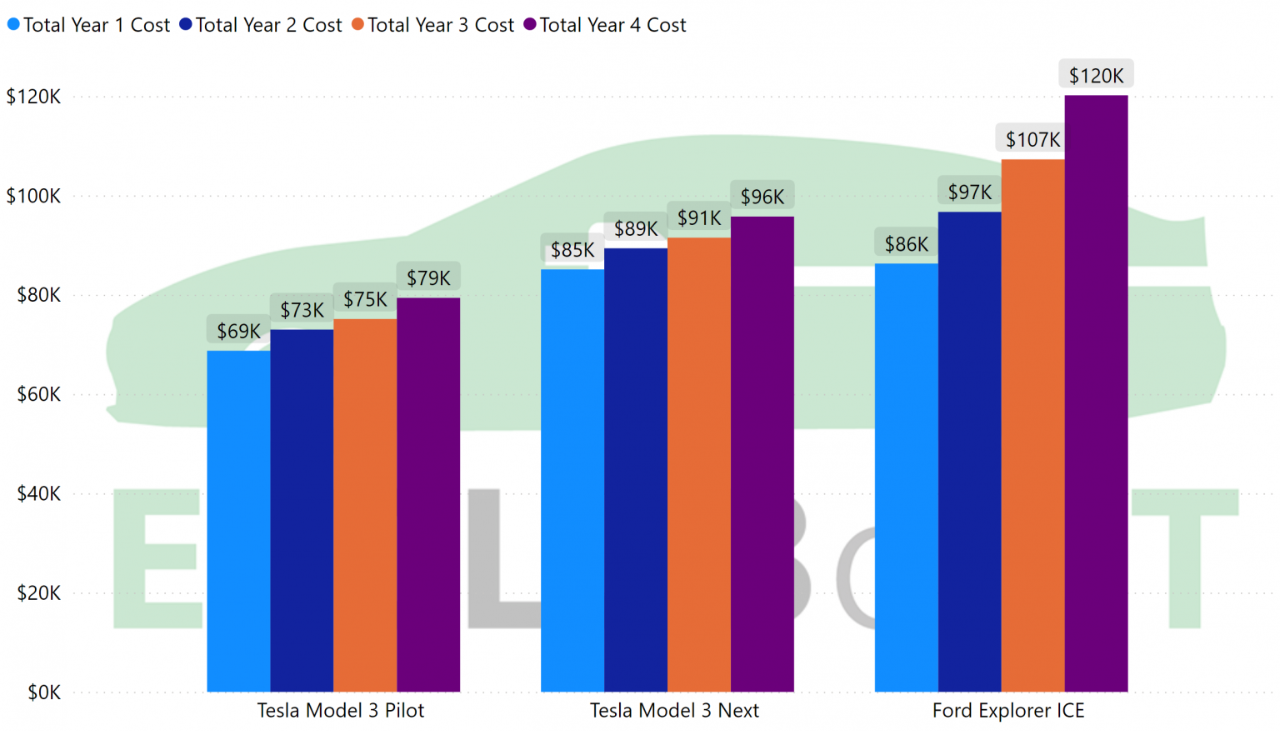
Cost amortization
Barry pointed out that so far, all charts have not considered the lifespan. Even based on the realization of revenue and payment principle, the cost of a Tesla car is much lower. The chart below uses the same classification format, dividing the fixed purchasing and customization costs by the lifespan of each car. Therefore, in this case, the fixed cost increases every year.
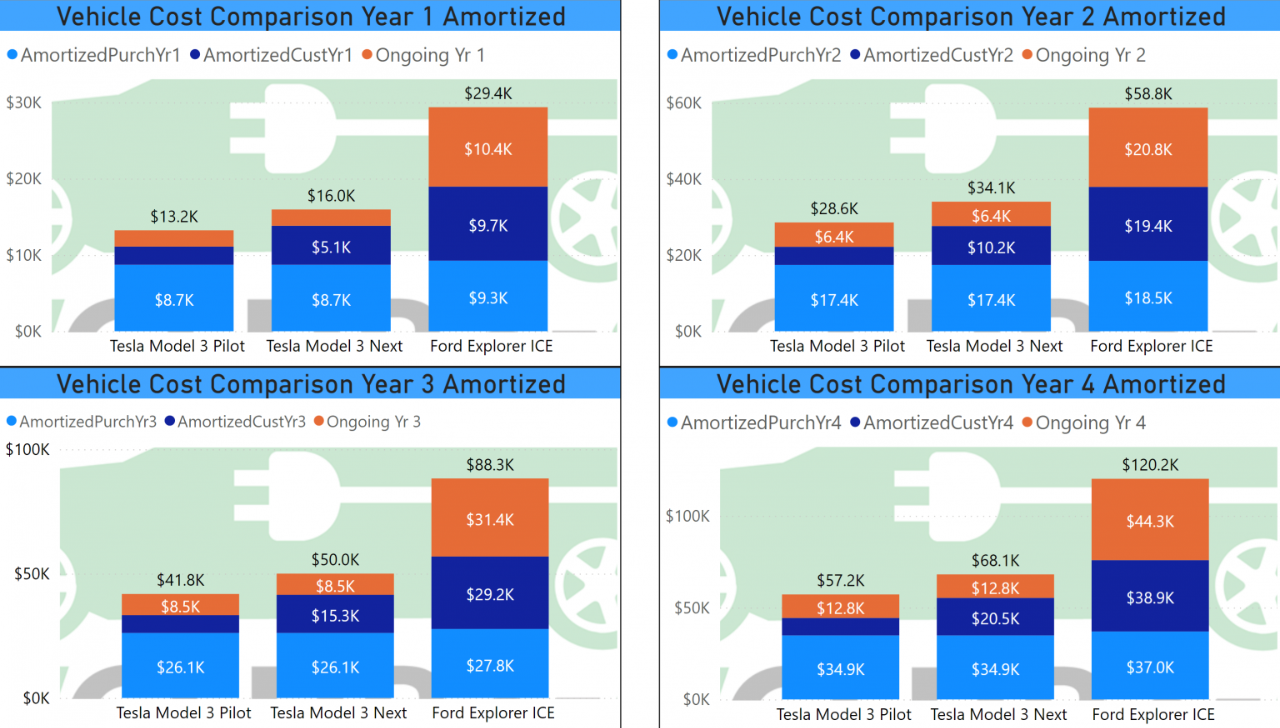
The following chart shows the total cost of each car annually, and the differences between Tesla and Ford Explorer can be seen. This is because, after four years, the purchasing and customization costs of a Tesla are only two-thirds amortized. However, in the fourth year, Ford’s costs are the same as those shown in the previous two charts because the vehicle has been fully amortized.
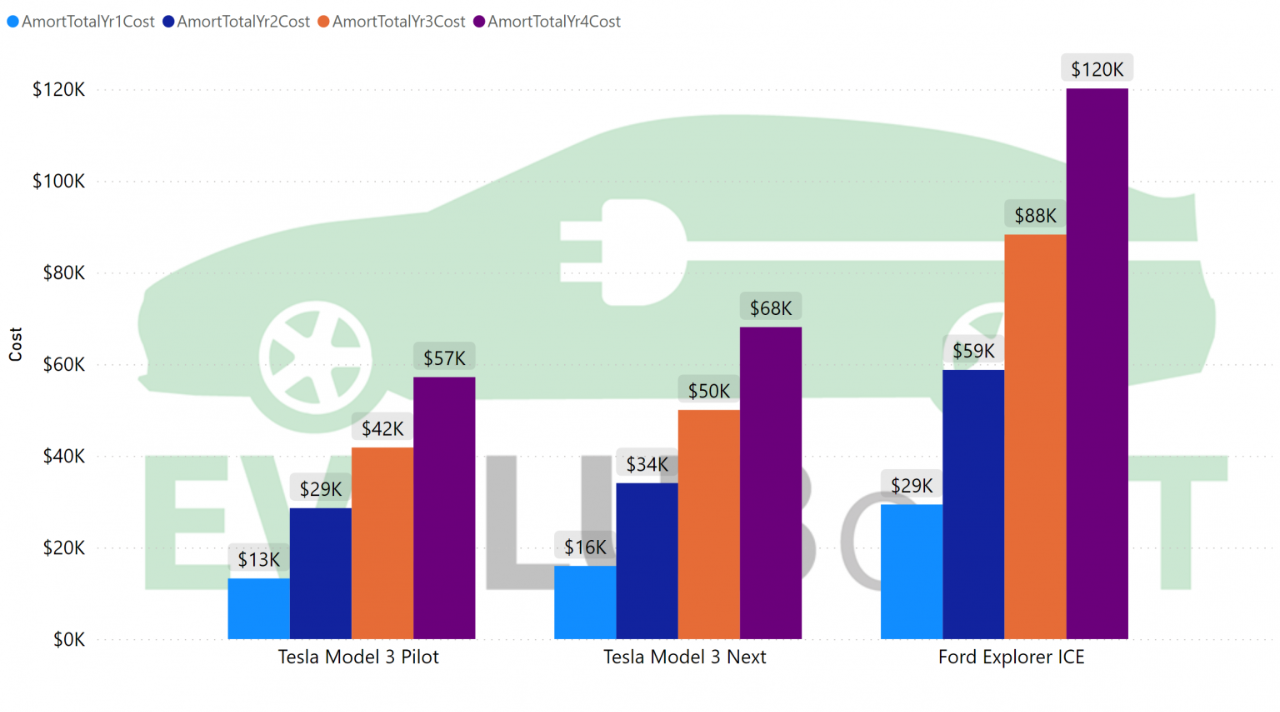
The following chart shows these differences more clearly, but Barry still calculated the savings for those who want to know the details. The two charts below show the savings of Tesla and the next Tesla based on cash and amortization, respectively.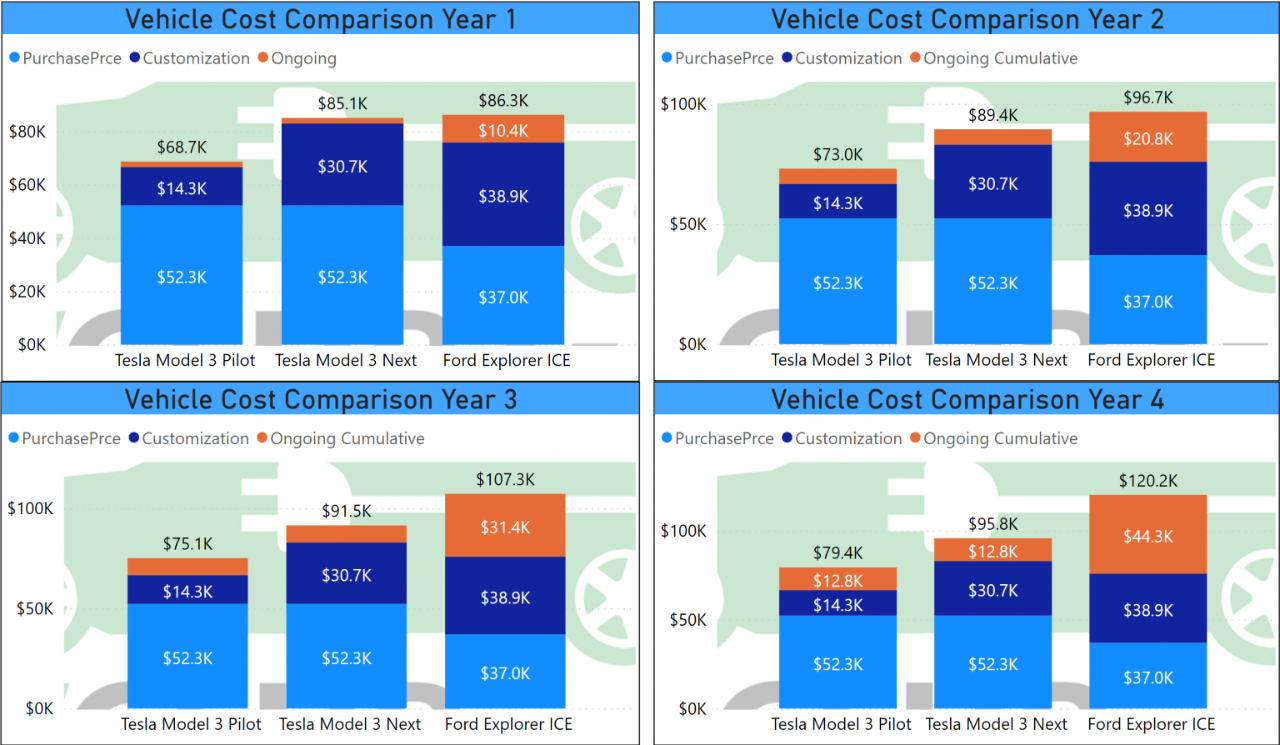
By amortization calculation, the Tesla to be put into trial use after four years will save $63,000. Based on the realization of receipts and payments, the next Tesla car will break even and the amortization basis is $52,000, which is the exact cost of the initial purchase price of the Tesla Model 3 when the police station bought it.
It is worth noting that the analysis shows the value of Tesla as both police cars and private cars. The best part of this is not saving money, but that these vehicles are cleaner and more environmentally friendly.
Since the data is so strong, Tesla has every reason to make it better and reassure people when using Tesla police cars and private cars!
This article is a translation by ChatGPT of a Chinese report from 42HOW. If you have any questions about it, please email bd@42how.com.